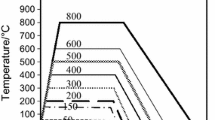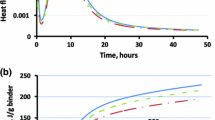Abstract
Concretes placed in thick structural elements experimence high hydration temperatures and restricted access to moist curing. This is particularly the case in concretes with relatively high binder contents and low water/binder ratios. Under high temperature curing, thermally reactive binders show significantly enhanced development of early age properties which may be there is currently very little data on either the early age or medium-term properties of concrete subjected to the combined impact of high temperature and restricted moist curing. This is particularly the case for blended cements containing supplementary cementitious materials, in spite of such binders being increasingly specified in all forms of construction. In this paper, the early and medium-term performance of high strength concretes containing blast furnace slag subjected to in-situ curing is described. The thermal reactivity of slag blended cements is evaluated in relation to key early age engineering properties, which in turn were found to develop at substantially different rates. The prediction of early age properties using equivalent age principles is assessed.
Résumé
Des bétons placés dans des éléments de structures épais subissent des températures d'hydratation élevées et un accès limité à une cure humide. Ceci est particulièrement vrai pour les bétons à haute teneur en liant et de faibles rapports eau/liant. Dans des conditions de durcissement à haute température, des liants réagissant à la température font preuve d'un développement accéléré des propriétés au jeune âge, qui pourront être exploitées pour augmenter la vitesse de construction. Cependant, à l'heure actuelle, très peu de données sont disponibles sur les caractéristiques à court ou à moyen terme des bétons soumis à l'effet combiné des fortes températures et d'un durcissement humide limité. Ceci est notamment le cas des ciments composés contenant des éléments pouzzolaniques supplémentaires, malgré la prescription de tels liants dans toute forme de construction. Dans cet article, les performances à court et moyen termes des bétons à haute résistance contenant du laitier de haut fourneau soumis à un durcissement in situ sont décrites. La réactivité thermique de ciments au laitier est évaluée par rapport aux principales propriétés au jeune âge, qui en revanche se développent à des taux très variables. Les prévisions des caractéristiques au jeune âge par l'application des principes de temps équivalent sont également évaluées dans cet article.
Similar content being viewed by others
References
Mak, S. L. and Lu, A., ‘Temperature effects on the early-age properties of high strength binder systems containing blast furnace slag’, Proceedings of the Second International Symposium on Blended Cements, Kuala Lumpur, Malaysia, Nov. 1994, pp. 71–76.
Mak, S. L., ‘Factors influencing the in-situ strength in high strength concrete columns’, PhD dissertation, Monash University, Melbourne, Australia, 1993.
Mak, S.L., Attard, M. M., Ho, D. W. S. and Darvall, P. LeP., ‘Effective in-situ strength of high strength concrete columns’,Australian Civil Engineering Transactions CE 35 (2) (1993) 87–93.
Wainwright, P. J. and Tolloczko, J. J. A., ‘Early and later age properties of temperature cycled slag-OPC concretes’, ACI SP-91, 1986 (American Concrete Institute) pp. 1293–1322.
Yurugi, M., Mizobuchi, T. and Terauchi, T., ‘Utilisation of blast-furnace slag and silica fume for controlling temperature rise in high strength concrete’, ACI SP-132, 1992 (American Concrete Institute) pp. 1433–1450.
Kokubu, K., Takahashi, S. and Anzai, H., ‘Effect of curing temperature on the hydration and adiabatic temperature characteristics of Portland cement-blast furnace slag concrete’, ACI SP-114, 1989 (American Concrete Institute) pp. 1361–1375.
Mak, S. L. and Torii, K., ‘Strength development of very high strength concretes with and without silica fume under semi-adiabatic temperature conditions’,Cement and Concrete Research 25 (8) (1995) 1791–1802.
Roy, D. M. and Idorn, G. M., ‘Hydration, structure and properties of blast furnace slag cements, mortars and concrete’,ACI Journal (Nov.–Dec. 1982) 444–457.
Ma, W., Sample, D., Martin, R. and Brown, P., ‘Calorimetric study of cement blends containing fly ash, silica fume and slag at elevated temperatures’,Cement, Concrete and Aggregates 16 (2) (1994) 93–99.
Carino, N. J., ‘The maturity method: theory and application’,Ibid. 6 (2) (1984) 61–73.
Author information
Authors and Affiliations
Rights and permissions
About this article
Cite this article
Mak, S.L. Thermal reactivity of slag cement binders and the response of high strength concretes to in-situ curing conditions. Mat. Struct. 33, 29–37 (2000). https://doi.org/10.1007/BF02481693
Received:
Accepted:
Issue Date:
DOI: https://doi.org/10.1007/BF02481693




